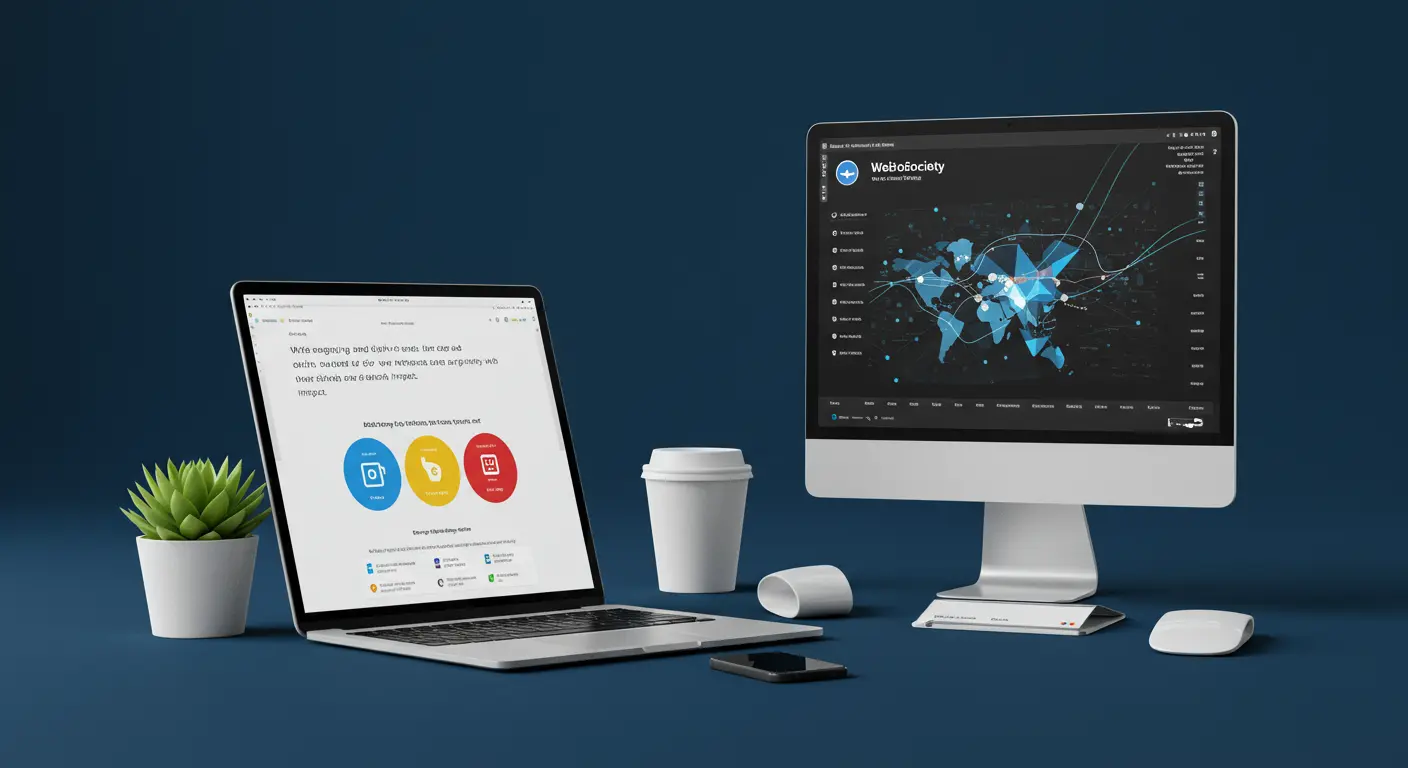In the quickly changing digital era of today, the internet is a potent instrument for social change rather than merely a place for convenience or enjoyment.

There is a growing trend in which digital platforms are being created for societal purposes as well as for financial gain. An “Online Platform Dedicated to Web To Society” is one such innovative idea that emphasizes using web technologies to address pressing social concerns, encourage inclusivity and create constructive change.
What is Web to Society?
An online ecosystem where digital interactions result in tangible social influence is known as “Web to Society.” A Web to Society platform prioritizes the following over typical social media, which concentrates on interpersonal relationships:
- Community driven conversations
- Collaborative problem solving
- Social awareness campaigns
- Crowdsourcing for societal benefit
Examples include websites like Kiva (crowdfunding for social causes), Change.org (activism) and even specialized forums devoted to education, mental health or sustainability.
Dedicated to Web to Society
Why Build a Web to Society Platform?

In a time when technology permeates every part of life, creating a Web To Society platform is more than just a technological undertaking; it is also a social and moral obligation. The internet has the potential to be a vehicle for inclusiveness, empowerment and transformation rather than only a platform for entertainment or business.
The following are some strong arguments for the necessity and significance of developing such a platform
1. Bridge the Digital Divide:
Digital opportunities are still inaccessible to millions of people globally. To help underprivileged communities, a Web To Society platform can be created that gives them online access to resources for jobs, healthcare, education and financial literacy.
2. Empower Grassroots Solutions:
Communities frequently have a greater understanding of their own problems than do outsiders. They may create and execute ideas locally with worldwide support and visibility if they are provided with digital tools and a collaborative platform.
3. Foster Social Innovation:
The platform serves as a spring board for innovative approaches to societal issues, whether they take the form of crowd sourcing tools, apps, websites or digital campaigns. Change makers and developers can work together to create technology that has an impact and produces quantifiable out comes.
4. Encourage Civic Engagement:
Tools like e-petitions, feed back forums, transparency dash boards and real time issue tracking can increase citizen participation in governance and policymaking. This promotes democracy, involvement and accountability.
5. Support Nonprofits and Social Enterprises:
Small social projects and NGOs frequently lack technological resources. They can expand their influence by using a Web To Society platform, which can give them free or inexpensive access to funding networks, web development tools, trained volunteers and publicity.
6. Global Problems Need Global Participation:
There are numerous worldwide issues, such as healthcare access, education disparity and climate change. People from various locations, backgrounds and skill levels can work together to solve common problems using a Web To Society platform.
7. Promote Ethical Technology Use:
Such a platform might encourage opensource, moral and transparent IT practices in an era of data exploitation and digital manipulation, demonstrating that the internet can still be a positive force.
https://www.getresponse.com/blog/best-online-community-platforms
How to Create a Web to Society Platform
Step 1: Define Your Niche
- Will it emphasize mental health, education, environmental activism or social transformation in general?
- For instance, a website devoted to “Zero-Waste Living” where people exchange advice, difficulties and neighborhood projects.
Step 2: Choose the Right Platform Type
- Forum based: For conversations (Discourse, phpBB).
- Fundraising through crowdfunding (integrations with Patrion and GoFundMe).
- Social networks like Mastodon and Buddy Press are useful for creating communities.
- Forums, blogs and action based tools are all combined in the hybrid model.
Step 3: Build & Customize
- To create a community website, use WordPress and Buddy Press.
- Think about bespoke development (React.js/Django) for more sophisticated functionality.
- Make sure the design is responsive.
Step 4: Engage & Grow the Community
- For example, “Connecting change makers for a better society” could be your goal statement at launch.
- To increase traffic, collaborate with activists, influencers and NGOs.
- Organize challenges, webinars and live debates to keep users interested.
Step 5: Monetize Sustainably
- Crowd funding and donation buttons
- sponsored material (only from ethical brands)
- Premium memberships (early access to campaigns, unique stuff)
Successful Examples of Web to Society Platforms

The internet can be a potent force for good, as demonstrated by the numerous platforms that have effectively combined web technology with social influence around the world. These platforms provide as examples of how digital tools can be utilized to empower people, strengthen communities and bring about significant change.
1. Change.org – Petitions for Social Justice:
People can start and sign online petitions on a variety of topics, from local community issues to global justice movements, using the popular website Change.org. Numerous petitions on the site have had a successful impact on governmental policy, business decisions and legislation.
2. Kiva.org – Crowdfunding Microloans for Entrepreneurs:
A charity website called Kiva enables users to make small loans to business owners in underdeveloped areas. Supporting women, students and small business owners without access to traditional banking is the main goal.
3. Meetup (Social Impact Groups):
Meetup enables users to start or join local groups, such as those centered around civic engagement, volunteering, sustainability and mental health. These live and virtual events promote action on significant social issues and build local networks.
4. Good Gym – Fitness Meets Volunteering:
A special website called Good Gym links runners with volunteer opportunities. Participants can run to support community projects or lonely seniors, fusing social service with personal well being.
5. Kiva – Microloans for Global Entrepreneurs:
Users can establish or grow their small enterprises by lending as little as $25 to entrepreneurs with modest incomes. The platform encourages communal improvement and financial independence.
Conclusion:
Creating a Web To Society platform involves more than just building a website; it involves using technology to make a difference in the real world. Now that digital resources are widely available, we have the chance to create platforms that address societal issues rather than just entertainment and business.
The reasons are obvious, as covered in “Why Build a Web To Society Platform?”: closing gaps in civic involvement, healthcare, education and the environment. When used carefully, these platforms can be effective instruments for empowerment and social change.
The “How to Create a Web To Society Platform” section emphasized that teamwork, inclusive design and purpose driven planning are essential for success. Every stage contributes to the platform’s effectiveness and sustainability, from establishing a clear objective to selecting the best technology and creating significant features.
Lastly, we have seen from the “Successful Examples of Web To Society Platforms” that this is not merely theory, but is actually taking place. Digital innovation can be both scalable and socially responsible, as demonstrated by platforms such as Tarjimly, Good Gym, Change.org and Kiva. A Web To Society platform is essentially a conduit between technology and people. It is a place where creativity and empathy coexist and the internet turns into a tool for more than just connecting; it is a tool for contributing. Now is the moment to create solutions that have an impact, regardless of your background developer, designer, social worker or just someone who wants to change the world.
Q. Why should someone build a Web To Society platform?
A Web To Society platform empowers people to use the internet for solving real-world social problems like education gaps, healthcare access, or community development. It transforms digital space into a tool for impact, inclusion, and social change rather than just entertainment or commerce.
Q. What’s the difference between a Web To Society platform and a regular website?
A regular website often focuses on business, marketing, or content sharing. A Web To Society platform, on the other hand, is mission-driven, designed to serve a social cause, and often includes features like volunteering, donations, collaboration tools, or educational content aimed at uplifting communities.
Q. How do I decide what issue my platform should focus on?
Choose an issue that is close to your heart and where you feel you can make a difference. It could be based on local community needs, personal experience, or global challenges like education, climate change, or healthcare inequality.
Q. How do I attract users to my Web To Society platform?
Start by engaging communities affected by or passionate about your mission. Use social media, local partnerships, storytelling, and word of mouth to build awareness. Focus on creating real value, and users will naturally follow.
Q. Can this platform scale globally?
Yes, with the right tech foundation and multilingual, mobile-friendly design, your platform can scale internationally. However, always start with local impact, test your model, and expand based on proven success.